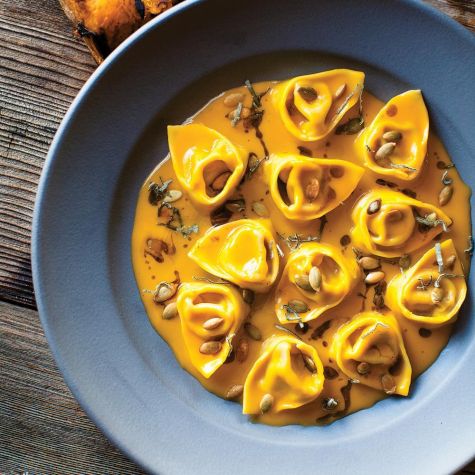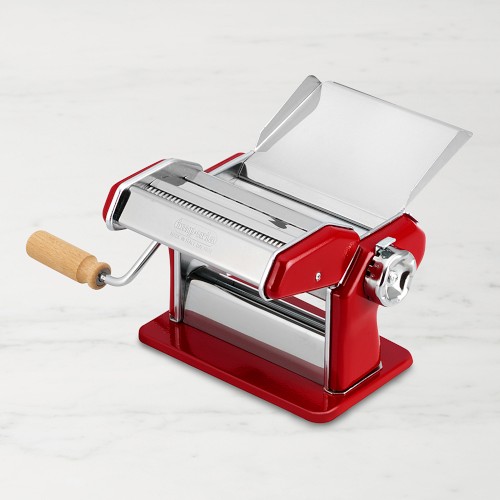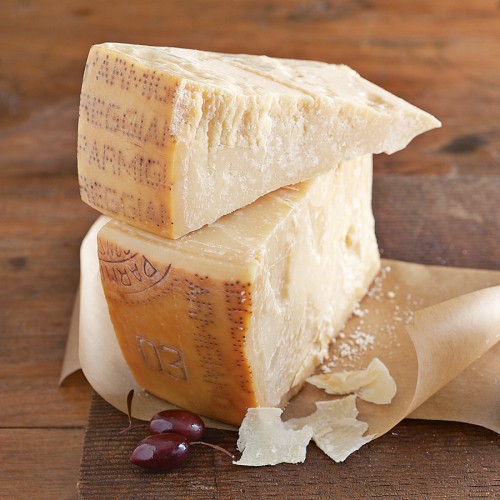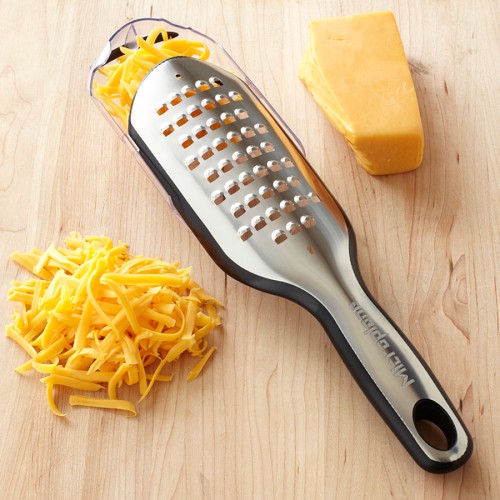
Pumpkin Tortelloni with Sage & Pumpkin Seeds
Tortelloni—a bigger version of tortellini, closer to a dumpling—is traditionally stuffed with pumpkin, nutmeg and Parmigiano-Reggiano. But beyond that starting point, the regional variations are countless. Chef Thomas McNaughton of San Francisco’s restaurant Flour + Water puts pumpkin seeds in the sauce, to give the tortelloni a little crunch and nuttiness, and he coats the pasta with a brown butter sauce. At his restaurant they often opt to use Cinderella pumpkins, which are great for fillings because they are naturally low in water. Butternut squash will also work well if you can’t find an heirloom pumpkin.
Ingredients:
- 1 batch Ravioli Dough
For the filling:
- 6 Tbs. (3/4 stick) (3 oz./90 g) unsalted butter
- 2 1/4 lb. (1 kg) Cinderella or other heirloom pumpkin or butternut squash, halved, seeded and stringy fibers removed (seeds reserved)
- Olive oil for drizzling
- Kosher salt, to taste
- 1/4 tsp. ground cinnamon
- 1/4 tsp. ground nutmeg
- 1 Tbs. apple cider vinegar
- 2 1/2 cups (6 oz./185 g) freshly grated Parmigiano-Reggiano cheese
- 1 Tbs. honey (optional)
Semolina flour for dusting
To finish:
- 3 Tbs. pumpkin seeds
- 1/2 tsp. olive oil
- Kosher salt, to taste
- 5 Tbs. (2 1/2 oz./75 g) unsalted butter
- 6 fresh sage leaves, finely slivered
- Freshly grated Parmigiano-Reggiano cheese for finishing
Directions:
Prepare the ravioli dough as instructed. Let rest for at least 30 minutes at room temperature. If resting for more than 6 hours, store the dough in the refrigerator. The dough will hold for up 2 days in the refrigerator, but it’s best to use it the same day you make it, because the egg yolks will oxidize and discolor the dough over time. Remove the dough from the refrigerator at least 30 minutes before rolling it out.
Preheat an oven to 350°F (180°C). Line a baking sheet with parchment paper.
Heat a sauté pan over medium heat and add the butter. Once the butter has melted and the foam has subsided, cook, stirring constantly, until the butter becomes a light tan color. Smell the butter; it should have a nutty aroma. Remove from the heat and set aside.
To make the filling, cut the pumpkin in half, drizzle with olive oil and season liberally with kosher salt. Place the pumpkin, cut side down, on the prepared baking sheet. Roast the pumpkin until fully tender when pierced with a knife, 45 to 60 minutes. The pumpkin should be soft to the touch but not mushy or deflated. Scoop out the flesh of the pumpkin and discard the rind. Add the warm pumpkin to a blender along with the brown butter, cinnamon, nutmeg and vinegar. Puree until smooth and season to taste with salt. The puree should have a nice balance of sweetness and acidity. If the pumpkin lacks sweetness and depth of flavor, add the honey to balance the flavor. Spoon the puree into a bowl and fold in the cheese. You should have about 3 1/2 cups (28 fl. oz./875 ml) filling. Cover and transfer to the refrigerator to cool.
Dust 2 baking sheets with semolina flour and set aside.
To make the pasta, slice off a section of the ball of dough, immediately rewrapping the unused portion in plastic wrap. Place the piece of dough on the work surface and, with a rolling pin, flatten it enough so that it will fit into the widest setting of your pasta machine. Begin rolling the dough through the machine, starting with the widest setting. Guide it quickly through the slot once. Then decrease the thickness setting by one and repeat. Decrease the thickness setting by one more and roll the dough through quickly one more time. Once the dough has gone through three times, once of each of the first three settings, it should have doubled in length.
Lay the dough on a flat surface. The dough’s hydration level at this point is so low that you’ll probably see some streaks; this is normal, which is the reason for the next crucial step: laminating the dough.
Using a rolling pin as a makeshift ruler, measure the width of your pasta machine’s slot, minus the thickness of two fingers. This measurement represents the ideal width of the pasta sheet, with about a finger’s length on each side, so there’s plenty of room in the machine. Take that rolling pin measurement to the end of the pasta sheet and make a gentle indentation in the dough representing the measurement’s length. Make that mark the crease and fold the pasta over. Repeat for the rest of the pasta sheet, keeping that same initial measurement. For best results, you want a minimum of four layers. Secure the layers of the pasta together with the rolling pin, rolling it flat enough that it can fit in the machine. Put the dough back in the machine, but with a 90-degree turn of the sheet. In other words, what was the bottom edge of the pasta is now going through the machine first.
This time around it’s important to roll out the dough to three times on each setting at a steady, smooth pace. If you roll it too fast, it will snap back to its earlier thickness, thereby lengthening the time you’re going through each number.
It’s important to maintain a consistent speed while cranking in order to keep a consistent thickness. You should be able to see and feel the resistance as the dough passes through the rollers. On the first time at each level, the dough will compress. It’s time to move onto the next level with the dough slips through without any trouble. The first few thickness settings (the biggest widths) usually require three passes; once you’re into thinner territory, there’s less pasta dough compressing, so it goes more quickly and two passes get the job done.
Keep rolling the dough until it is just translucent, or just slightly thinner than 1/16 inch (2 mm). If you can see the outline of your fingers behind it, or the grain of the wood table through the pasta, you’re in good shape. For most (but not all) hand-cranked pasta machines at home, it’s the second-to-last setting. Cut a 2-foot (60-cm) section of the dough sheet and cover the rest of the dough with plastic wrap.
Using a straight wheel cutter or sharp knife and a ruler, cut the dough into 2 3/4-inch (7-cm) squares. Using a piping bag or spoon, place 2 tsp. of filling into the middle of each square. Fold the pasta in half so the opposite corners meet, forming a triangle. Use a spritz of water from a spray bottle to help seal it if necessary. Gently press out the air around the filling by running your fingers from the tip of the triangle downward. With your thumbs along the base of the triangle and your index fingers halfway down each side of the triangle, gently pinch your index fingers and thumbs together and rotate your left index finger to fit under the base of the triangle. Wrap the corners around your left index and middle fingers and pinch them together to seal. You should have a small gap between the filling and the pinched dough, like a ring.
Working quickly, place the tortelloni on the prepared baking sheets, spaced apart, until ready to cook. Don’t let the tortelloni touch each other or they may stick together. Repeat until you run out of dough or filling. You should have 30 to 40 pieces.
Preheat an oven to 350°F (180°C). Bring a large pot of salted water to a boil.
In a small bowl, stir together the pumpkin seeds with the olive oil and a pinch of salt. Spread the seeds on a baking sheet and toast until golden brown, about 11 minutes. Transfer to a plate and set aside.
Drop the pasta into the boiling water. Meanwhile, heat a 12-inch (30-cm) sauté pan over high heat. Add 1/4 cup (2 fl. oz./60 ml) of the seasoned pasta water and the butter and bring to a simmer. Once the pasta is cooked 80 percent through, until almost al dente, about 2 to 3 minutes, add it to the pan along with the sage and swirl until the sauce coats the back of a spoon. Reserve the pasta water. If needed, add a few more tablespoons of pasta water to keep a saucy consistency and continue cooking until the pasta is tender, about 90 seconds. Season with salt.
To serve, divide the pasta and sauce between 4 plates. Sprinkle with Parmigiano-Reggiano and the toasted pumpkin seeds and serve immediately. Serves 4.
Adapted from Flour + Water: Pasta, by Thomas McNaughton with Paolo Lucchesi (Ten Speed Press, 2014)












